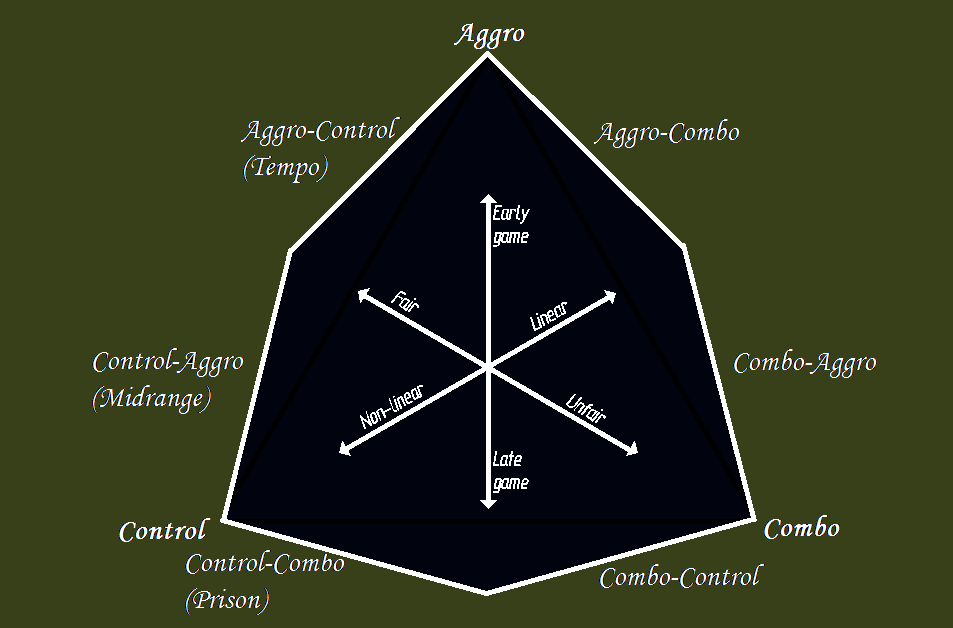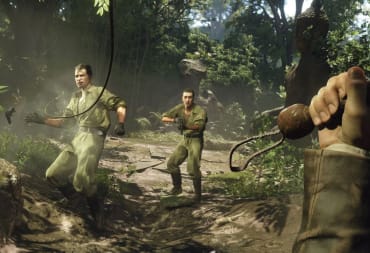In our last entry in TechRaptor's Magic: The Gathering archetype primer series, we took an in-depth look at the Control archetype and the Jeskai Harbinger deck. As a reminder, Magic: The Gathering consists of nine archetypes: the three general archetypes (Aggro, Control, Combo) and their permutations (Aggro-Combo, Combo-Aggro, Combo-Control, Control-Combo, Control-Aggro, Aggro-Control). And again, this archetype primer series is only looking at decks in the Modern Magic: The Gathering format; Legacy and Vintage decks will be covered at another time, and Standard typically consists of Control, Aggro, and Aggro-Control, making it a poor learning environment for the purpose of this series.
The below infographic illustrates each of the nine archetypes in Magic: The Gathering, and what qualities they possess (when decks want to win, how decks want to win, and how they interact with their opponent).

This week, we'll be taking a look at the Combo archetype and at one of its representative decks, Blue/Red Storm, which makes use of mana rituals and the Storm mechanic to deliver a big, lethal amount of damage in a single turn. Combo is, in general, an archetype that isn't well-represented in Modern, which tends to be dominated by very fast, very aggressive linear decks that don't suffer from disruption, especially as some of Combo's best mana rituals are either banned in Modern (such as Rite of Flame and Seething Song) or aren't legal to play in Modern (such as Dark Ritual). The other issue lies in Eidolon of the Great Revel; this creature card is a staple of Burn decks, and while the Aggro match-up is a very favorable one for us, our opponent having one or more out on the board puts us a very real risk of killing ourselves.
In addition, Wizards of the Coast rarely prints cards that are viable for use in Blue/Red Storm, and considers Storm to not be a mechanic worth returning to anytime soon. This means that Blue/Red Storm is a very niche deck; you'll likely run into it at your local game store's Modern events, but very rarely at anything more competitive.
Before we cover Blue/Red Storm in earnest, we need to figure out how the Combo archetype works. So, let's begin: what is the Combo archetype?
Magic: The Gathering Archetype - Combo
Combo is a proactive archetype that focuses on winning games either in the early-game or the middle-game through the use of "one-shot kill" chains. Very few creatures are run in Combo, and the ones that are run tend to have some kind of effect on the casting cost of our instant and sorcery spells. Decks in the Combo archetype are "semi-linear," only interacting with our opponent to protect our chain or if there's a massive threat on board.While Combo decks carry semi-redundancy in terms of a few effects, we play as though we have little to no redundancy, constantly casting the same spells to dig into our library for missing combo pieces. As such, Combo decks suffer highly from disruption and counterspells.
In general, decks in the Combo archetype are strong against Aggro archetype decks. Because Aggro focuses on linear strategies, we don't have to fear our chain being disrupted and can deal lethal damage much faster. The only concern when playing against Aggro decks is to make sure we don't bring our life total too low through the use of fetch lands, shock lands, and Phyrexian mana cost.
On the other hand, Combo decks are weak against Control decks. As each card in our combo goes onto the stack, it gives Control players the opportunity to counter it, bounce it back to our hand, or otherwise interrupt our chain whenever they want to. Winning against Control can require us to have a better opening hand and quite a lot of lucky topdecks.
Combo decks require very careful card sequencing. Players who pilot Combo decks need to track what mana is in their mana pool, as well as their Storm count if they're playing decks that involve the Storm mechanic (which most pure Combo decks will). A very common mistake is miscounting available mana or the Storm count and beginning your combo chain only to fizzle out.
Knowing this, let’s take a look at Blue/Red Storm in-depth. What cards do typical builds use?
Blue/Red Storm - Lands
Blue/Red Storm focuses primarily on blue mana-producing lands, as our mana rituals already produce some number of red mana, and we want to spend our early turns casting our card draw spells. We only need one red source of mana when it comes time to start our combo chain, and we only need sixteen to eighteen lands total.Let's begin with fetch lands; we're going to want to run a full playset of Scalding Tarns, as that hits both of the land types we run in our deck. We also want to run three to four copies total of Misty Rainforest, Polluted Delta, and Flooded Strand; most players chose to split these three fetch lands equally, running one copy each in order to evade any hate cards that rely on specific card names. How you chose to build the blue fetch lands depends on what is run in your meta.
We'll also want to run two to four copies of the shockland Steam Vents. Steam Vents is a valid target for our fetch lands, and the life loss is irrelevant against most decks with the exception of those that rely on burn spells. The pain land Shivan Reef is another land we'll want to run two to three copies of in our deck, as while it can't be fetched, it is less taxing on our life in the early game.
The rest of our lands should consist of one basic Mountain and however many Islands needed to bring the land total up to the desirable number. Don't worry about trying to run other blue/red lands—like Sulfur Falls, Wandering Fumarole, or Spirebluff Canal—we want our lands to enter the battlefield untapped and without having to worry about needing to have a certain number of basic lands in play.

Blue/Red Storm - Card Draw and Mana Rituals
Card draw and mana rituals are the core of Blue/Red Storm. Card draw spells dig through our library, finding us the missing pieces of our combo chain, while also helping to set up future draws. Card draw spells also help to increase our Storm count when we're looking to start our combo chain.Much like in Control, we're running three to four copies of Serum Visions. This handy card lets us set up our future draws while also keeping sub-optimal hands and replaces itself. Sleight of Hand functions similarly, with the difference being that it digs two cards deep before drawing to replace itself. Run four copies of each.
We'll also be running three to four copies of Gitaxian Probe, although its purpose is less in digging for cards, but in checking out our opponent's hand to see if the way is clear to begin our combo chain. Most of the time it'll be cast for "free" using the Phyrexian mana cost, but keep an eye on your match-up; if your opponent is playing Burn strategies, you'll want to make sure you can afford paying two life instead of one blue mana.
Thought Scour is a rather interesting card with a variety of uses. We can target ourselves to put cards in our graveyard to help trigger Pyromancer Ascension sooner or we can utilize it as a way to mill our opponent's library into their graveyard. It also replaces itself; as such, run anywhere from two to four copies.
Cathartic Reunion is a new card from Kaladesh and is worth some consideration, mainly for how deep it digs into our library. It's also a red card draw spell, which is very relevant as we don't have to filter mana from our mana rituals using Metamorphose to cast it, unlike our blue card draw spells. Desperate Ravings is also another red card draw spell but has the caveat of discarding a card at random. Choose whichever card you feel more comfortable using and run three to four copies of it.
Peer Through Depths digs an amazing five cards deep into our library and lets us tutor for a missing combo piece. The issue with Peer Through Depths, however, is that it only tutors for instants and sorceries, meaning it can whiff and be a waste of mana if we hit a land pocket. Run just a couple copies of it.
Now we move onto our mana rituals, which is this deck's acceleration, generating the mana needed to draw more cards or kick off our combo chain. Our two primary mana rituals are Desperate Ritual and Pyretic Ritual—always run four copies of each. Splice is a very unusual keyword ability from Champions of Kamigawa that essentially allows the player to add the rules text of the card with Splice to a card with the Arcane subtype. The only card with the Arcana subtype that we play is Peer Through Depths, but the main reason we run these is to generate mana to play more spells and grow our storm count.
The other mana ritual we run is Manamorphose, although strictly speaking this is a mana filter and not a mana ritual. We utilize Manamorphose to turn the red mana from our rituals into the blue mana needed to cast card draw spells and also to dig a bit into our library. Always run four copies of Manamorphose.
Another option to consider running is Simian Spirit Guide, which is a good way to restart your combo chain if it gets interrupted by Control decks. However, it doesn't add to the Storm count and doesn't interact with our engines as it is neither an instant or a sorcery.
Blue/Red Storm - Engines and Win Conditions
Our next section is on our engines—cards that provide bonuses when we play specific cards or help to enable our combo. The most important of these cards is Pyromancer Ascension, which works beautifully as we run many full playsets of instants and sorceries. Once we have two quest counters on Pyromancer Ascension, we can very easily dig deeply into our library and also have some protection from counterspells (as the copy will need to be countered separately).Goblin Electromancer is absolutely essential for Blue/Red Storm, as it maximizes the efficiency of our mana rituals. Have one of these out on the field, and your rituals will generate three red mana for one, instead of three red mana for two. The only problem is that Goblin Electromancer is an obvious target for burn spells and other creature hate, so you want to save him for when you're ready to start your combo chain (and if he is targeted for removal, you can cast a ritual in response and still get the mana reduction). Run three to four copies.
Our final engine is Past in Flames, which gives every single card in your graveyard Flashback - cast this when you have two quest counters on Pyromancer Ascension and you can get some amazing interactions. The only problem is the converted mana cost; it's very expensive, and you never want to draw multiples. Run three copies.
Blue/Red Storm runs two win conditions, one of which we keep in our sideboard. Our mainboard win condition is Grapeshot; you'll want a Storm count of ten when you cast it and either have a second copy in hand, a Pyromancer Ascension with two quest counters on it, or a Past in Flames to give the copy in your graveyard Flashback. Run four copies of Grapeshot.
Our sideboard win condition is Empty the Warrens, which generates a large number of Goblin creature tokens with a high Storm count. The issue with this is that they're weak to removal or widespread destruction spells like Anger of the Gods. Run four copies in your sideboard.
Blue/Red Storm - Sideboard
As with all decks, what we run depends heavily on what our meta environment is like. However, there are three categories of cards we should have in our sideboard: our alternate win condition Empty the Warrens, cards to protect our combo chain, and specific hate cards for match-ups.For creature removal, we'll want to run Lightning Bolt and Flame Slash. Both are capable of dealing with certain problematic creatures our opponent controls (such as Eidolon of the Great Revel). Lightning Bolt can also be used to sneak extra damage in and make a lower Storm count Grapeshot more effective.
Dispel, Spell Pierce, and Pact of Negation are excellent counterspells to help protect our combo chain when we're trying to go off and only when we're trying to go off—Pact of Negation especially, as we have to pay the upkeep cost otherwise we lose the game.
Gigadrowse is a very cheap way to tap down our opponents lands on the turn before we go off, creating a clear path for our combo.
You'll also want to run Echoing Truth, which takes care of enchantment-based hate like Leyline of Sanctity.
Our final piece of combo protection is Defense Grid, which makes it very difficult for our opponent to counter our combo pieces.
For specific hate cards, we can run Hurkyl's Recall and Shatterstorm to deal with artifact-based decks and Anger of the Gods for decks that rely on mass creature or token strategies. Blood Moon also helps to shut down two-or-three color decks that don't run red spells or mana sources. Unlike other Modern decks, which pack a lot of "silver bullet" hate spells to deal with many decks, Blue/Red's sideboard should exclusively be for the worst match-ups you face in your meta-environment.

Blue/Red Storm - Sample Deck and Match-ups
TechRaptor staff have created a sample decklist on Tappedout.com for our readers to view. Take into account that this is a sample decklist; it is by no means definitive and doesn’t have a sideboard as it doesn’t take into account your meta environment.Knowing how our deck plays against other decks is very important knowledge to have, as it will guide us on what cards to sideboard in after the first match. Therefore, in each article of our primer series, we’ll touch on how some of our match-ups go and what cards we can use in matches two and three. Because the decks in Modern’s Tier 1 change from time to time and are typically slanted towards linear gameplay, we’ll focus on the decks that will be featured in our primer articles.
Mono-Red Burn (Aggro): Until the printing of Eidolon of the Great Revel, this was a very favorable match-up for us. Now, it's less so, but with careful playing can still be advantageous. In game one we'll have to waste a Grapeshot with Storm count two to remove their Eidolon of the Great Revel. Things get a little easier in games two and three when we sideboard in creature removal like Lightning Bolt and Anger of the Gods
Mono-Black 8Rack (Control-Combo): 8Rack is focused primarily on locking down their opponent from attacking or from having many cards in their hand. Winning requires us to get our combo off as early as possible before they neuter our hand. Sideboard cards like Echoing Truth can be used to deal with Shrieking Affliction or The Rack if the life loss becomes a problem.
Affinity (Aggro-Combo): Affinity is very fast, so we'll want to board in all of our artifact hate in games two and three for our slower card draw spells. We'll also want to bring Lightning Bolt in to take out early threats.
Mono-Blue Merfolk (Aggro-Control): Merfolk puts down a lot of pressure on us and can use their disruption to interfere with our combo chain. Expect Merfolk players to aggressively mulligan in games two and three to get their disruption spells.
Jeskai Harbinger (Control): Our worst match-up. Control can shut us down at any point they feel like it, and there's very little we can do about it.
Blue/Red Storm (Combo): The mirror match-up is very skill intensive, requiring us to navigate intensive interactions with our opponents. Gitaxian Probe is of little help to us in the mirror match, as both our hand and our opponent's changes very frequently.
Black/White Tokens (Contol-Aggro): The first game is in our favor, but most Black/White Token decks will carry Leyline of Sanctity and Rule of Law in their sideboard to interfere with our combo. Sideboard in Echoing Truths and Gigadrowse to keep them from interfering with us.
Temur Scapeshift (Combo-Control): The Valakut, the Molten Pinacle combo is very slow compared to our combo, so as long as we can get our combo off before they get theirs off, we're in very good shape in this match-up. The main thing to keep an eye out for is their counterspells.
Abzan Company (Combo-Aggro): A very hard match-up, Abzan Company tends to carry infinite lifegain combos, so the strategy when playing against Abzan Company should be to utilize Thought Scour to mill their library.
Generally speaking, most games with Blue/Red Storm will involve trying to get the combo off as early as possible, as the deck isn't meant to play very long games.
The next article in TechRaptor's Modern Magic: The Gathering archetype primer series will be on the Aggro-Combo archetype and the Affinity deck.
Stay tuned to TechRaptor for more news and editorials on all things Magic: The Gathering.
What were your thoughts on this competitive Magic: The Gathering primer? Did you find it useful? Let us know in the comment section below.
Have a tip, or want to point out something we missed? Leave a Comment or e-mail us at tips@techraptor.net













